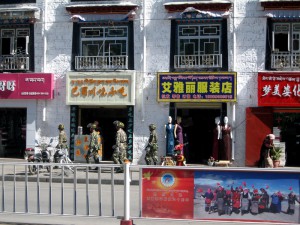The Tibetan government in exile based in Dharamsala, India, has released powerful footage shot in a village outside Lhasa of Tibetan homes being raided and laypeople being detained in a major police and special forces operation in 2008. The footage, which has been subtitled into English (an ICT transcript is below) can be viewed at: http://www.tibetonline.tv/ and also on Youtube. The sheer scale of the operation may be because some of the individuals seen being detained were among those to be the first to be sentenced following the protests and rioting in Lhasa in March, 2008.
A series of disturbing images also from 2008 in eastern Tibet have also been released online by Tibetans and posted on boxun.com (an online Chinese news site based overseas) and the blog of Tibetan writer Woeser, and can be viewed below. The images depict monks with placards around their necks reminiscent of the Cultural Revolution being taken away from their monastery by armed troops, and laypeople being dragged away, bent double, by People’s Armed Police in riot gear. In another image, monks are seen with heads forced down over the side of an open army truck, still with the placards announcing their “splittist” activities around their necks. The location of all of the photographs is unknown, although several of the images have been identified as Ngaba (Chinese: Aba) Tibetan and Qiang Autonomous Prefecture in Sichuan province.
Rare footage depicts chilling scenes of raids and detentions following 2008 protests
The 22 minutes of footage of police raids shows police entering individual family compounds at dawn in the village of Dog-sde (Chinese: Duode xiang 夺底乡), a rural area near Sera monastery in the Lhasa environs. According to the Tibetan government in exile, which received the video from sources it did not identify, the individuals depicted being detained are apparently suspected of involvement in protests by monks from Sera and nuns from Chusang nunnery on March 11, 2008.
The footage shows a total of eight people – seven men and one woman – being detained, although a list that appears in the hands of police in the video suggests police were targeting at least ten people for detention. The sheer display of force to detain these unarmed individuals, who are mostly in bed at home when the police arrive, is notable; the video shows personnel from at least three branches of the police involved in the sweep.
The security personnel in black uniforms and helmets, many of whom are carrying assault weapons – and who appear to be leading the operation – are Special Police, although some are also seen carrying long sticks; several of whom have plain clothes beneath their vests and helmets, and not all of these personnel appear to be armed. The normal civilian police are involved, identified in some instances by the characters “Jing Cha” and “Police” in English on their vests; while those in green camouflage uniforms and black helmets often seen carrying only a truncheon, are from the People’s Armed Police Border Defense, according to the characters clearly seen on the sides of their helmets throughout the video.
Soon after being detained, each individual is presented to the camera and ordered to state their name and age. The names and other details of the individuals and the circumstances of their detention are as follows:
1. Tsering Norsang, age 32 (3’44”). A sequence of video starts by showing Tsering Norsang being hauled to his feet by several police having apparently just had his hands restrained behind his back. Tsering Norsang is heard saying “I swear I didn’t do anything.” A woman’s voice in the background is also heard saying in Tibetan that he hadn’t done anything.
2. Jampa Gyaltsen, age 53 (6’21”). Jampa Gyaltsen is barefooted when he first appears in the video. A woman appears in the doorway behind him and apparently drops shoes on the floor for him while also carrying what appears to be a jacket for him. He is then led out of his compound and made to kneel next to another unidentified man. As the unidentified man is led away, the personnel on either side of him force his head down and pull his arms up behind his back.
3. Phurbu Ngodrup, age 29 (12’07”). Security personnel can be seen gathering to enter Phurbu Ngodrup’s compound at 10’27”. With the gate locked, an officer scales the wall just as another kicks the gate open. More than a dozen officers flood into the courtyard and a struggle can be heard. Once he is outside in the courtyard, an officer pulls Phurbu Ngodrup’s head back to show a bloodied lip as he states his name and age to the camera. He is heard asking if he can put shoes on, but he is kicked and punched by officers before being led away. As he is led past the camera, two men in black uniforms and helmets without any visible insignia are seen also filming proceedings.
4. [Name not clear], female, age 45 (14’25”). The police enter a compound saying they are looking for someone called Sonam Tsering. The Tibetan cameraman states “She says he has gone to make a call,” and someone off-camera says in Tibetan “Maybe he knew that we were coming”. Two officers can be seen examining green household registration (hukou) booklets, and they are then heard asking the whereabouts of two people named as Tsewang and Lobsang. The woman says they have gone out to make tsampa (roasted barley flour), but then the woman is seen being led away police, apparently in detention, although her hands are not restrained behind her back.
An officer is seen examining a household registration booklet at 16’00” which he then compares against a Chinese-language document bearing several hand-written additions and ticks, looking for the name “Choegyal.” The details of at least 10 people appear to be on the list.
5. Nyima Tsering, who states his age as “27 to 28″ (17’25”). When police enter his room, Nyima Tsering is seen getting out of bed and putting trousers on over is underclothes. The camera pans around the small room, showing at least nine officers watching over him – ten including the camera operator. When he’s presented to the camera outside in the courtyard, a woman behind him is heard crying and saying “You shouldn’t have done it, now we’re all going to suffer.”
6. Pasang, age 38 (18′ 48″). Two security personnel lead Pasang up an incline in a road towards the camera, where he states his name and age (and a lot more is said in this exchange. It’s all in Tibetan, but at the end of it, someone says in Chinese, “That’s him.”). According to a Tibetan analyst in exile, this may be the same Pasang (Chinese: Basang) who was sentenced to life imprisonment by Lhasa City Intermediate People’s Court on April 29, 2009 for his alleged role in the protests in Lhasa.
A long stream of vehicles is seen leaving the village, including armored personnel carriers, unmarked four-wheel drives, and buses.
7. Gonde [?], age 45 (20’11”). Police enter a compound where at least two vehicles are parked, and Gonde is seen being detained. Besides being asked name and age, Gonde is also asked where he is from. Police can be heard in the background saying “Quickly, quickly, bring them” and “wait a little bit, wait a little bit” at one point. Additional words can be heard in the background, but it is unclear what is being said.
8. Phurbu, age 22, (21’25”). Two security personnel are seen running towards the camera along an alley between two compounds, bringing Phurbu with them.
The video closes showing a convoy of police vehicles returning to a police station in an urban setting, and two further unidentified individuals are seen being taken from a minibus with their hands restrained behind their backs.
While the current whereabouts and well-being of the above mentioned remains unknown to ICT, on April 29, 2008, Chinese authorities announced the first sentences of Tibetans, ranging from three years to life, since the protests and unrest began on the Tibetan plateau on March 10, 2008. According to Xinhua, the state news agency, among the 30 Tibetans whose sentences were announced was a monk named Pasang and Sonam Tsering, a driver with a Lhasa real estate company. Both men received life sentences (ICT report, 30 April 2008).
A report by Human Rights Watch stated that actual trial proceedings, in which evidence from the prosecution was introduced, had been conducted covertly on undisclosed dates earlier in April, and that the Tibetans were denied access to a meaningful defense with lawyers they had chosen (HRW report, 30 April 2008). In an image released by the state media of the trial, one of the prisoners is sitting on a chair, which some observers have noted could mean they were unable to stand following torture.
Images from eastern Tibet show scenes of arrest reminiscent of Cultural Revolution
The images released on Boxun and by Woeser (see below) are of the intense security crackdown that was implemented in the Ngaba Tibetan and Qiang Autonomous Prefecture, Sichuan province after Tibetan protestors demonstrated during the wave of protests that swept across the Tibetan plateau beginning in March, 2008.
The images show a military checkpoint along a road, riot gear-clad troops marching through a town while brandishing assault rifles, as well as riot gear-clad troops leading Tibetans away for detention, some of whom are monks wearing placards around their necks on which their name and charges are written, reminiscent of the Cultural Revolution.
In one of the images that was released, a group of six monks can be seen hanging out of a military truck while wearing placards around their necks that contain their name and their alleged offense. The names on the placards of three of the six monks can be read: Gongqu Yanlian or Yanzao (Tibetan: Kunchok Shonnu), Gongqu Zahua (Tibetan: Kunchok Drakpa), and Gongqu Daji (Tibetan: Kunchok Darge); the charges all of the monks are accused of appears to be “Inciting others to damage state property.”
Another image reminiscent of the Cultural Revolution depicts at least three monks with placards around their necks being lead away from their monastery by armed security personnel. The name “Luorang Nuoba” (a Chinese transliteration of a Tibetan name) and the charge “Splittist” can be read on the placard around the neck of the middle monk.
The Ngaba area, the Tibetan area of Amdo, continues to face a strict security crackdown. Nine of the 13 self-immolations since February, 2009 have taken place in Ngaba. One of the 13, a 20-year old monk named Phuntsog, set fire to himself on March 16 of this year, the third anniversary of a 2008 protest near Kirti monastery in Ngaba county town during which at least 10 peaceful Tibetan demonstrators where shot dead by security forces (ICT report, 16 March 2011). Among those who were killed was Lhundup Tso, a 16-year old Tibetan school girl (see ICT report, “A Great Mountain Burned by Fire,” March, 2009).
[divider style=”dashed”/]
Click images for larger view.
[one_half]
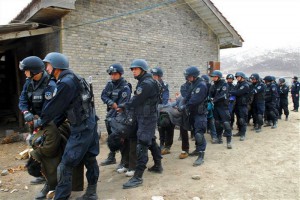
[/one_half]
[one_half_last]
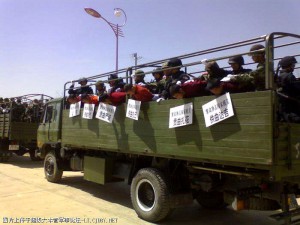
[/one_half_last]
[one_half]
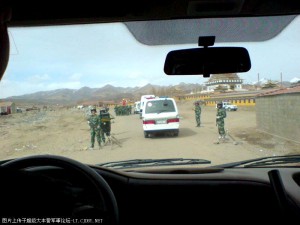
[/one_half]
[one_half_last]

[/one_half_last]
[one_half]
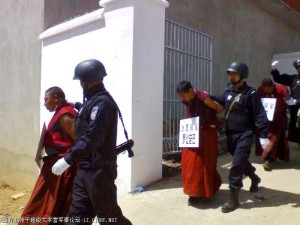
[/one_half]
[one_half_last] [/one_half_last]
Eyewitness reports from Lhasa of sustained militarization
A Western visitor who has recently returned from Lhasa has given a detailed account of the continued militarization and climate of fear in the city, more than three years on from the scenes depicted in the video footage of the immediate aftermath of the protests in March, 2008.
The visitor told ICT: “Lhasa is in a state of armed military, police, and special forces control. The town is heavily patrolled and check posts are in every corner of the area between the Jokhang temple (including the mosque) and the Potala Palace. The Barkhor circular road has at least 19 police posts with four to six security armed personnel. Special forces members dress blue colored uniforms and always carry plastic handcuffs on the shoulders.
“Army soldiers are in charge of patrolling the old town and they are divided into patrolling soldiers and sentinels. The former walk always in groups of five, with two in the front one in the middle and two in the back. Four of them are equipped with automatic rifles, while one carries a fire extinguisher on his back [a development that is likely to follow the self-immolations in eastern Tibet]. The sentinels are evident in the entrances to small alleys, gates to temples, and so on. They are placed in such a way that each of them can securely cover every direction of potential attack. Finally, sharp-shooters and snipers are posted on a number of rooftops; I counted at least five places, most of them in the immediate vicinities of the Jokhang temple, the center of Tibetans’ religious practice.
Armed troops in combat uniform are posted at the former gateway to the town of Lhasa, where the white stupas are. This symbolic entrance to the city is a central landmark of the Buddhist character of the town. It is impossible to take a picture of the traditional Lhasa vista – the Potala Palace with the white stupas at its foot – without including the soldiers posted there.”
